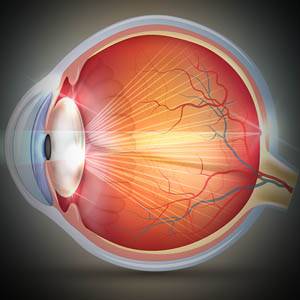As you age, you may discover that your vision just isn’t as sharp as it used to be.
Vision changes can occur over time and cause you to wonder if what you are experiencing is normal or if you should schedule an appointment with your eye doctor.
While some age-related vision changes can lead to mild vision impairment that may require a pair of reading glasses, other vision changes can cause more significant vision impairments that may require medication or surgery.
Moreover, some vision changes may not be related to aging at all, and may require immediate treatment to protect your vision.
Therefore, if you notice any changes to your vision, is it always best to consult with your eye doctor.
The Find an Eye Doctor directory can provide a list of eye doctors near you that can discuss the changes you may experience as you age and provide effective management and treatment options to help you maximize your vision.
SEE RELATED: Am I at Risk of Vision Loss?
1. Cataracts
Cataracts occur when proteins from the eye’s lens begin to accumulate on the surface of the lens. When this happens, the eye’s naturally transparent lens becomes more opaque— leading to cloudy or blurred vision.
Cataracts generally develop overtime, typically from the age of 40.
As they gradually develop, you may first notice your distance vision becoming more blurry or even a temporary improvement in your near vision.
As the cataract gradually progresses, the lens will begin to turn yellow, and sometimes even brown. This can lead to difficulty distinguishing between shades of color, and if left untreated, can eventually lead to total vision loss.
Fortunately, cataracts can be treated with surgery, in which the cloudy lens is replaced with a clear artificial lens.
2. Eye conditions
As we age, our risk of developing serious eye conditions increases.
The most common conditions diagnosed among older adults include: Glaucoma, both dry and wet age-related macular degeneration, other macular conditions and and diabetic retinopathy.
Unfortunately, in many cases, these conditions don’t present with noticeable symptoms until permanent ocular damage has occurred— also resulting in some degree of vision loss.
In order to protect your eyes from these sight-threatening conditions, eye doctors recommend having an annual eye exam beginning from age 40, when your risk of developing these conditions significantly increases.
3. Ptosis
Ptosis is characterized by a drooping of the upper eyelid.
This condition can affect one or both eyes. The severity of the eye droop will determine if your vision will be affected or not— in some cases, the eye droop may cover the pupil and block vision, while in other cases, the eye droop is slight and hardly noticeable.
Ptosis occurs as a result of a weakness of the levator muscle, the muscle responsible for lifting the eyelid. This condition can be caused by aging, eye surgery, or an eye disease that affects the levator muscle or nerve. Ptosis is generally corrected with surgery.
4. Posterior vitreous detachment
Posterior vitreous detachment (PVD) occurs when the gel-like substance in the back of the eye begins to shrink and pull away from the retina.
This is a normal part of the aging process, but can cause eye floaters and sometimes even flashes of light in the visual field that may take you by surprise.
5. Presbyopia
As we age, the lens inside the eye begins to lose its flexibility and its ability to bring near objects into focus— resulting in blurry near vision. Presbyopia, also known as age-related farsightedness, typically affects adults beginning from age 40.
When this occurs, reading glasses are usually required for near-vision tasks, such as reading, texting, knitting, and even computer use.
Some people will require multifocal lenses that contain multiple powers— for near, intermediate, and distance vision impairments.
6. Reduced pupil size
With age, the muscles that control the size of the pupil and the pupil’s reaction to light, begin to weaken. This leads to a reduced pupil response to changes in ambient or poor lighting and causes the pupils to appear smaller than normal.
As a result, you may notice halos around lights while driving, and find it difficult to read or use a computer in dimly lit environments.
7. Dry eye
While dry eye syndrome can affect people of all ages, older adults are more susceptible to this condition since the quality and quantity of their tears tend to diminish over time.
Fortunately, there are eye drops, gels and ointments that can offer long lasting relief of dry eye symptoms.
8. Loss of peripheral vision
Aging has been shown to cause a loss of peripheral vision by 1-3 degrees for every decade of life.
In fact, some people reach a peripheral vision loss of 20-30 degrees by the time they reach their 70th birthday.
While peripheral vision loss can be a normal part of aging, it can also indicate the presence of a serious eye disease, such as glaucoma. Therefore, if you notice any vision changes or vision loss, schedule an eye exam to rule out any conditions that may require immediate attention.
9. Decreased color vision
As we age, the cells in the retina responsible for color vision begin to diminish.
This can make it difficult to distinguish between different colors and also result in colors appearing less vibrant.
While this generally occurs as part of the natural aging process, it can also occur as a symptom of a more serious eye disease, such as age-related macular degeneration. It is therefore best to keep up with your regular eye exams to monitor your ocular health and protect your vision.
Routine eye exams are essential for maintaining ocular health.
Most serious eye diseases can even be detected even before symptoms are noticed. Your eye doctor will examine your eyes and perform a series of tests to ensure that your eyes remain healthy and your vision intact.
LEARN MORE: Guide to Eye Health
If you have been noticing changes to your vision, schedule an appointment for an eye exam.
Your eye doctor will discuss the changes that can occur as you age, and help you to effectively maximize your vision.









